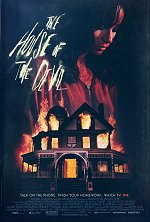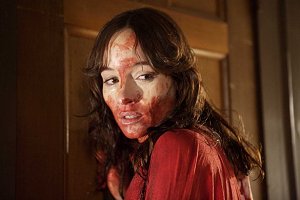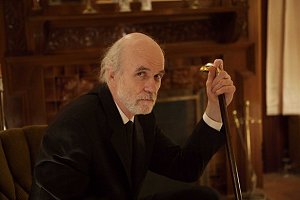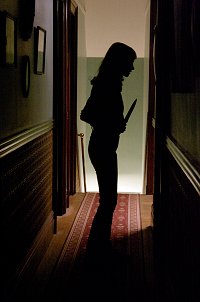 |
|
At The Picture Show
|
December 2009
Third-act blues
'The House of the Devil' is two-thirds of a horror classic, one-third of an inexplicable cheat

The House of the Devil
Magnet Releasing
Director: Ti West
Screenplay: Ti West
Starring: Jocelin Donahue, Tom Noonan, Mary Woronov, Greta Gerwig, AJ Bowen and Dee
Wallace
Rated R / 1 hour, 33 minutes
Now playing in limited release


 (out of four)
(out of four)
Look at that star rating. Look at it and know that it should have been significantly higher. The
House of the Devil is a great horror film . . . for about an hour. And then it devolves into an all-too-familiar sense of mindlessness.
If the build-up hadn't been so strong to begin with, the third act probably wouldn't have played
so poorly. It just would have been par for the course. But this movie is better than that. And it
knows it. And yet it doesn't know how to follow through, how to resolve itself.
 The near-agonizing degree of patience writer-director Ti
West displays curiously dissolves, and the movie turns into just another dumb exercise in
bloodletting, eschewing all logic in the process. What do the final act and "gotcha!" denouement
achieve but easy resolutions? It's as if West did such a good job letting things simmer that he
eventually just got impatient with himself and decided, "You know what? Let's hurry up and get
this thing good and bloody. Screw everything else."
The near-agonizing degree of patience writer-director Ti
West displays curiously dissolves, and the movie turns into just another dumb exercise in
bloodletting, eschewing all logic in the process. What do the final act and "gotcha!" denouement
achieve but easy resolutions? It's as if West did such a good job letting things simmer that he
eventually just got impatient with himself and decided, "You know what? Let's hurry up and get
this thing good and bloody. Screw everything else."
But oh, what could have been. Judging from the film's opening credits and West's clear grasp
on the genre, he seems to have a bit of Tarantino in his blood. Not only is The House of the
Devil set in the early 1980s, but distinctly evokes that late '70s/early '80s style - right down to
the film stock, shot compositions and even the one-sheet poster.
But there's only minor pastiche value here - West opts for a straightforward horror story of
almost comforting familiarity and simplicity. Young coed needs money to pay the rent on her
new pad, finds a gig house-sitting at a strange old house out in the middle of nowhere, things
eventually take a turn for the worse.
The film warns us from the beginning about an unexplained rash of Satanic cult killings in the
1980s, so we know what our wholesome, chaste-looking heroine, Samantha (Jocelin Donahue),
will be in for. But what's so effective is how long West makes us wait for it.
 He shows that he has that most important gift of a
horror/suspense director - the ability to create a mood that feels more real and physical than any
piece of set dressing. He instills a sense of unease that runs up until the point of absolute
agitation. Samantha picks up a flier for the house-sitting gig, she calls the number. No one
picks up. She leaves, but the phone booth remains in the foreground while she walks away in the
distance. You, the viewer, know full well that phone is going to ring back . . . and it's going to
happen . . . any . . . second.
He shows that he has that most important gift of a
horror/suspense director - the ability to create a mood that feels more real and physical than any
piece of set dressing. He instills a sense of unease that runs up until the point of absolute
agitation. Samantha picks up a flier for the house-sitting gig, she calls the number. No one
picks up. She leaves, but the phone booth remains in the foreground while she walks away in the
distance. You, the viewer, know full well that phone is going to ring back . . . and it's going to
happen . . . any . . . second.
A man introduces himself, assuring Samantha that she'll be doing him a great favor on such
short notice. Let's meet up in a half-hour. And so she goes to the designated meeting place and
waits. And waits and waits. Nothing. Eventually, Mr. Ulman (played by the always great Tom
Noonan) gets back in touch and gives Sam the address. A bit uncertain at this point, she decides
to bring her friend Megan (Greta Gerwig) along for the ride - which turns out to be a longer
commute than they expected. Of course.
The house is just what you'd expect - old-fashioned, dark, creaky. But just watch how West
heightens the suspense just by his treatment of silence, awkward gaps in conversation - the
length that he holds seemingly innocuous shots. Samantha meets Mr. Ulman in person, and in a
memorable display of cinematic creepiness, Noonan almost sheepishly wills her to stay - for
what we know will be a night of terror - even after admitting that this gig isn't babysitting at all,
but house-sitting for an invalid old woman.
He explains how important this particular night is for him and his wife (Mary Woronov). It's the
lunar eclipse, you see. Consider Noonan's unassuming voice and appearance in this scene - as
he apologizes for his little fib, you're not sure if that's an embarrassed smile on his face or a
sinister grin suppressing his eager anticipation for what is to come. Probably both. I can't
imagine another actor pulling off these scenes in quite the same way.
 The scenes that follow continue to build on that sense of
disquiet. Samantha is uncomfortable in this house, but she doesn't know why. Up to a point,
The House of the Devil is pure atmosphere and fine craftsmanship - and was on its way, I
thought, to being one of the defining horror movies of this decade. Then it takes a small, curious
turn with the plot - which I was willing to forgive, until it turned into an outright assault on our
collective intelligence.
The scenes that follow continue to build on that sense of
disquiet. Samantha is uncomfortable in this house, but she doesn't know why. Up to a point,
The House of the Devil is pure atmosphere and fine craftsmanship - and was on its way, I
thought, to being one of the defining horror movies of this decade. Then it takes a small, curious
turn with the plot - which I was willing to forgive, until it turned into an outright assault on our
collective intelligence.
There's one scene, for example, in which Samantha is captive in a room full of people - and
somehow manages to escape in a matter of seconds. The spatial orientation in this sequence is
disastrous. It makes no sense. The purpose of the plot development is that it allows for a series
of bloody horror scenes - none of which carry any of the power they should have. They seem
almost obligatory. Stab, gouge, run away, run away, kill, run away. Rinse, repeat.
If West is simply trying to be "true" to the logic of certain '80s horror flicks, and that's his
rationale for the idiocy of the final act, then he's unintentionally nudging his film toward irony -
something he so thoroughly avoided during the previous hour.
When I think back on that hour, my admiration for it only grows. When I think back on the final
section, however, disappointment is the only response.
Read more by Chris Bellamy